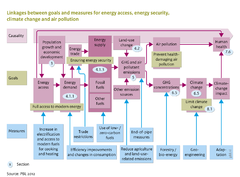Air pollution and energy policies/Data uncertainties limitations
Parts of Air pollution and energy policies/Data uncertainties limitations
| Component is implemented in: |
| Related IMAGE components |
| Projects/Applications |
| Key publications |
Data, uncertainty and limitations
Data
The quality and availability of data differ for energy security, access and air pollution. For energy security, data inputs to IMAGE are obtained indirectly by calibrating to IEA data for the historical period. Few global data are available for energy access. This implies that the model has been calibrated mostly to national data for key countries such as China and India, and then applied to all IMAGE regions. There are more inventories for air pollution emissions. Data for IMAGE are obtained from the EDGAR database.
Uncertainties and limitations
Another challenge is policy representation. Data on diverse energy policies are difficult to obtain, and several policies are not easily represented in a model. For instance, energy security policies often do not contain clearly formulated targets and associated policy instruments, but tend to be more abstract in the formulation of preferred directions combined with incentives for domestic production.
In IMAGE, assumptions and simplifications have been made to assess energy policies. A key issue, for instance, is the focus on centralised grids only. Decentralised and off-grid or mini-grid options may be preferable and more economical in rural regions. Similarly, for supplying heat, local alternatives may be attractive, such as locally produced biogas. For energy security, the key indicators in IMAGE are depletion, trade and diversity, while other aspects of energy security, such as accessibility and acceptability, are poorly represented. As stated above, emission reduction measures for air pollution cannot be modelled explicitly. This has to be done by adjusting emission factors based on more detailed data. Air pollution policies are also not specified in terms of costs. The use of emission factors also implies that specific consequences, such as increases in other types of emissions and loss of energy efficiency, are difficult to address.
